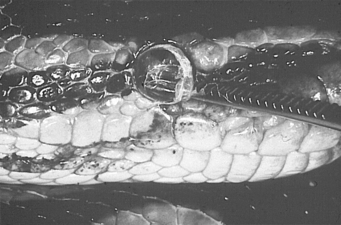Chapter 41 Diseases of the Special Senses
SNAKES
Retained Spectacles
Spectacles cover the entire surface of the cornea in the snake. These spectacles undergo changes during the shedding cycle, becoming cloudy before the shed, then clearing after shedding is completed. Retention of the spectacles is a common condition seen in pet snakes and, in many cases, is a result of low humidity in the environment (Fig. 41-1).

Figure 41-1 A retained spectacle in a snake.
(From Mader DR: Reptile medicine and surgery, ed 2, St. Louis, 2006, Saunders. Courtesy S. Barten.)
TREATMENT
• Removal of the retained spectacle without injuring the cornea can be done as follows:
Place snake in a warm container lined with damp paper or soak the animal in warm water to loosen the spectacle; some have used wet cotton balls over the spectacles to soak.
Stay updated, free articles. Join our Telegram channel

Full access? Get Clinical Tree


